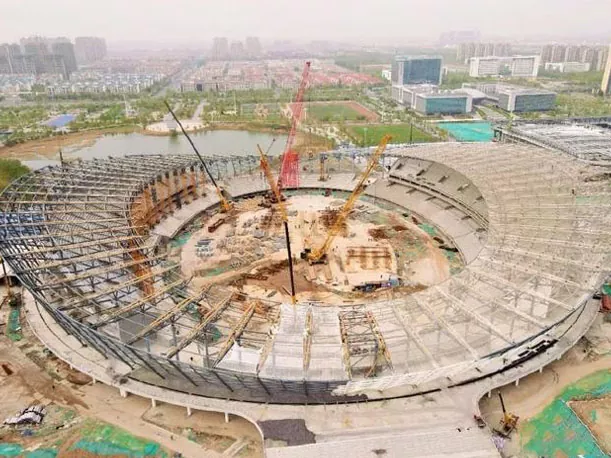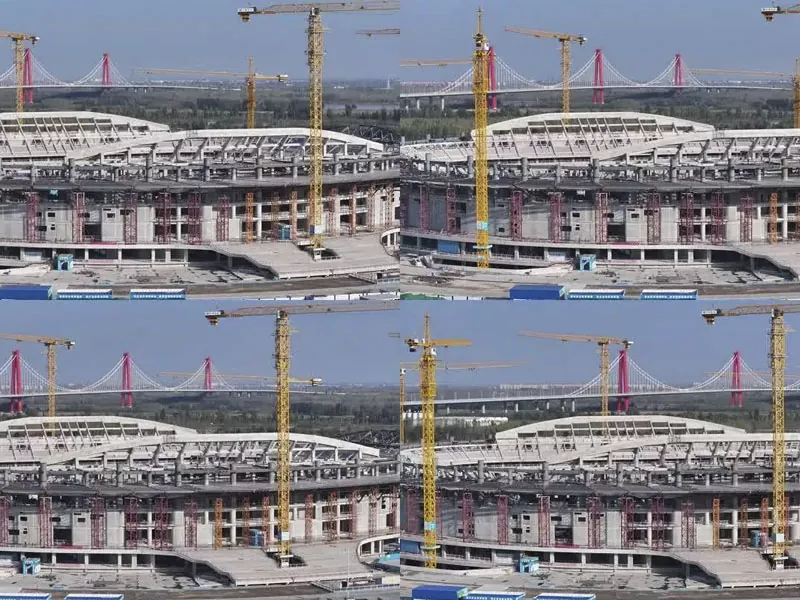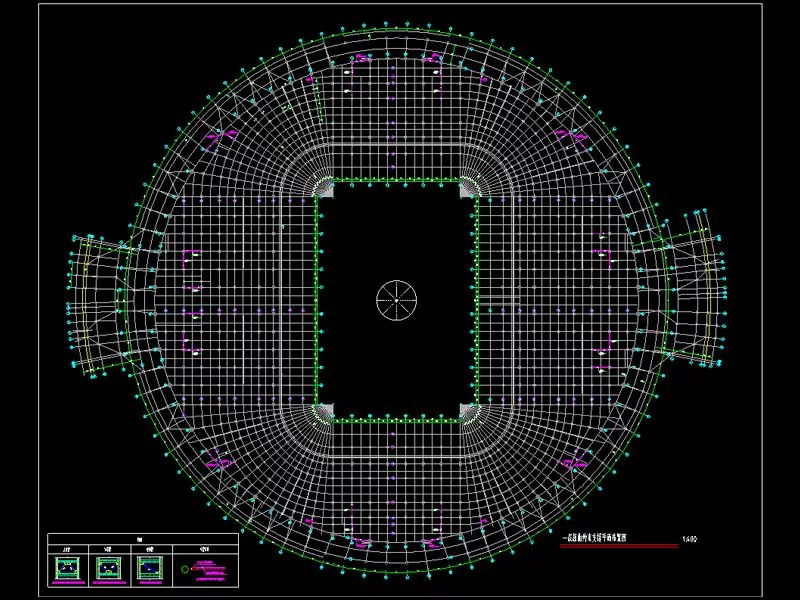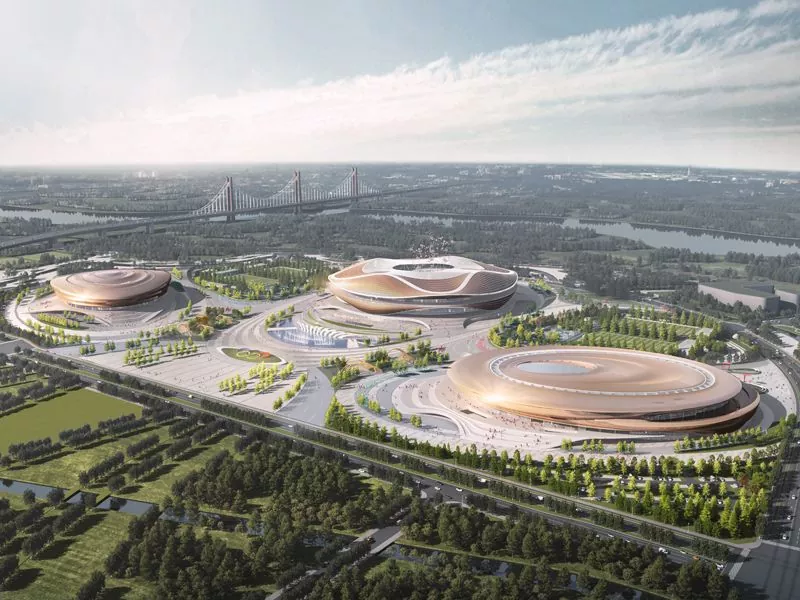QR Code

Products
Contact Us


E-mail

Address
No. 568, Yanqing First Class Road, Jimo High-tech Zone, Qingdao City, Shandong Province, China
Industrial Steel Building Construction Looking for an energy-efficient building that can meet all of your needs? Look no further than our Energy-Efficient Metal Framed Building.
One of the key features of our Energy-Efficient Metal Framed Building is its high-quality construction. Made from durable, long-lasting materials, including sturdy metal framing, this building is designed to withstand even the harshest weather conditions. And because it's reinforced with extra insulation and other energy-saving features, it can help you save money on your utility bills over time.
Speaking of energy-saving features, our Energy-Efficient Metal Framed Building comes loaded with them. From solar panels and natural lighting to advanced HVAC systems and smart thermostats, this building is engineered to minimize waste and maximize efficiency. Plus, it's built with sustainable materials and can be customized to include even more green technology options.
But that's not all. Our Energy-Efficient Metal Framed Building is also designed with comfort and convenience in mind. With spacious, open floor plans, plenty of natural light, and modern amenities like state-of-the-art security systems and high-speed internet access, it's the perfect space for any business or organization.
So whether you're looking to house your growing business, create a community space, or build a sustainable home, our Energy-Efficient Metal Framed Building has everything you need. Contact us today to learn more about this innovative, eco-friendly building solution.
1. What is a metal-framed building?
A metal-framed building is a structure that utilizes steel or other metal components as its primary structural support system. The columns, beams, and other load-bearing elements are generally made of metal, and they are joined together with bolts, welding, or other connections. These buildings are often pre-fabricated, which means that the components are manufactured off-site and then assembled on-site. Metal-framed buildings are commonly used for industrial facilities, warehouses, commercial buildings, and even residential homes. They offer several benefits over other construction materials, including durability, cost-effectiveness, and versatility.
2. What are the advantages of constructing a metal-framed building?
Constructing a metal-framed building offers numerous advantages that contribute to its popularity in various construction projects. Here are some of the key benefits:
1)Strength and Durability: Metal frames are renowned for their exceptional strength and durability. They are capable of withstanding heavy loads and severe weather conditions, ensuring the stability and safety of the structure.
2)Flexibility in Design: Metal framing provides a high level of flexibility in design. It can be easily customized to fit different shapes, sizes, and configurations, allowing for greater creativity and innovation in architectural designs.
3)Faster Construction: Metal framing systems are prefabricated, which means they can be assembled quickly and efficiently on-site. This significantly reduces construction time, saving both time and money.
4)Energy Efficiency: Metal frames are excellent conductors of heat, which can be advantageous in terms of energy efficiency. Proper insulation can help maintain a comfortable indoor temperature, reducing the need for heating and cooling systems.
5)Corrosion Resistance: Many metal framing materials, such as stainless steel and aluminum, have excellent corrosion resistance. This means they can withstand exposure to moisture and other corrosive elements, making them suitable for use in coastal or high-humidity areas.
6)Cost-Effectiveness: Although the initial cost of metal framing may be higher than traditional framing materials, its long-term durability and reduced maintenance costs often offset this initial investment.
7)Eco-Friendliness: Metal is a recyclable material, making metal-framed buildings more environmentally friendly. The use of recycled metal in construction also helps reduce the demand for virgin materials, further reducing the environmental impact of construction projects.
Overall, the advantages of metal-framed buildings make them a viable and attractive option for a wide range of construction projects, from residential homes to commercial buildings and industrial facilities.
3. Can metal-framed buildings be used for commercial and residential purposes?
Yes, metal-framed buildings can indeed be used for both commercial and residential purposes. Their versatility and adaptability make them suitable for a wide range of applications.
For commercial uses, metal-framed buildings offer a durable and cost-effective solution. They can be easily customized to fit the specific needs of a business, such as retail stores, warehouses, and offices. The strength and stability of metal frames ensure the safety of employees and customers, while their energy efficiency helps to reduce operating costs.
For residential purposes, metal-framed buildings provide a modern and stylish alternative to traditional construction methods. They can be designed to suit any architectural style, from contemporary to traditional, and can be easily integrated into surrounding landscapes. Metal frames also offer excellent resistance to fire and pests, providing added safety for homeowners.
In both commercial and residential settings, metal-framed buildings are known for their durability and ability to withstand severe weather conditions. This makes them a particularly good choice in areas prone to high winds, earthquakes, or other natural disasters.
Overall, the adaptability and durability of metal-framed buildings make them an excellent option for both commercial and residential applications.
4.Are metal-framed buildings safe during natural disasters?
Generally speaking, metal-framed buildings are considered to be quite safe during natural disasters compared to many other types of construction. This is because the metal components of the building provide a high level of structural integrity and durability, which can prevent collapse or damage during events such as earthquakes, hurricanes, and severe storms. Additionally, because metal-framed buildings are often pre-engineered and designed to strict building codes, they are usually able to withstand high winds and other severe weather. However, it's important to note that the safety of any building during a natural disaster depends on many factors, including the specific design of the structure, the quality of its construction, and the severity of the event.
5. How long does it take to construct a metal-framed building?
The time it takes to construct a metal-framed building can vary depending on a variety of factors such as the size of the building, complexity of design, site location, and climate conditions. Generally speaking, metal-framed buildings can be erected faster than traditional buildings made of concrete or masonry, and the use of prefabricated components can significantly reduce construction time.
For example, a small metal building with a standard design may only take a few weeks to construct once the site is prepared. However, larger and more complex buildings may take several months to complete. Additionally, local building codes and permitting requirements can also impact the overall construction timeline. Ultimately, the construction time will depend on the specific project and various other factors, so it's best to consult with a professional contractor for a more accurate estimate.
6. What are the maintenance requirements for metal-framed buildings?
One of the benefits of metal-framed buildings is that they require relatively low maintenance, but there are still some recommended maintenance tasks to keep them in good condition. Here are some examples:
Regular cleaning: Dirt, debris, and other contaminants can accumulate on the surface of metal components, which can lead to corrosion or discoloration. Regular cleaning of the exterior of the building with a mild detergent or pressure washer can help prevent this.
Inspection: Regular inspections of the building's structural components, such as the metal framing and roofing, can help identify any damage or wear early on. This can allow for timely repairs and minimize potential problems.
Painting and Coating: The metal components of the building should be painted or coated with a protective finish to resist corrosion and extend their lifespan. The frequency of repainting can vary depending on the type of coating used and other environmental factors such as exposure to salt air or harsh weather.
Gutter cleaning: Metal buildings with gutters should have them cleaned regularly to prevent blockages which can cause water buildup and lead to water damage.
Pest management: Metal buildings, particularly those located in rural areas, may attract pests such as birds, rodents, and insects, which can cause damage and affect the building's appearance. Regular pest management can help prevent damage and infestations.
Overall, regular maintenance can help ensure the longevity and structural integrity of metal-framed buildings.
7. What is the lifespan of a metal-framed building?
The lifespan of a metal-framed building can vary depending on several factors, including the quality of the construction, the type and thickness of metal components, the quality of maintenance, and the environmental conditions in which the building is located.
However, properly maintained metal-framed buildings can last several decades or even a century. Many manufacturers of metal building components offer warranties that guarantee the material against structural failure for 25 to 50 years or more. With proper maintenance, the building can last even longer. Factors that can contribute to the longevity of a metal-framed building include regular inspections, prompt repairs, and the use of protective coatings and finishes.
Ultimately, the lifespan of a metal-framed building will depend on the specific project, the surrounding environment and quality of maintenance it receives over time.
8. How energy-efficient are metal-framed buildings compared to traditional construction methods?
Metal-framed buildings can be designed to be highly energy-efficient and offer several advantages over traditional construction methods in terms of energy performance.
For example, metal-framed buildings can be insulated and sealed to reduce air leakage, which can significantly reduce heating and cooling costs. Additionally, metal roofing is highly reflective, which can reduce heat gain during the summer, leading to lower cooling needs.
There are also other ways to improve energy efficiency in metal-framed buildings, such as adding windows that maximize daylight and ventilation, using energy-efficient HVAC systems, and incorporating renewable energy sources like solar panels.
Overall, metal-framed buildings can be very energy-efficient and offer many opportunities for energy-saving measures. However, it's important to ensure the design and construction are optimized for energy efficiency to ensure the building operates as intended.
9. Can metal-framed buildings be customized to fit specific design needs?
Yes, metal-framed buildings can be customized to fit specific design needs. Metal framing systems offer a high level of flexibility and adaptability, allowing for a wide range of customization options.
Designers and architects can work with metal framing manufacturers to create unique and innovative structures that meet specific requirements. This includes customizing the shape, size, and configuration of the frames to fit the desired architectural style and function. Metal frames can also be integrated with other materials, such as glass, stone, or wood, to create a seamless and cohesive design.
In addition, metal framing systems can be tailored to meet specific structural requirements. Engineers can calculate the necessary load-bearing capacity and design the frames accordingly, ensuring the stability and safety of the structure.
Furthermore, metal frames can be finished with a variety of coatings and paints to match the desired aesthetic. This allows for a high degree of personalization and allows the building to blend into its surrounding environment or stand out as a unique architectural feature.
Overall, the customization options available with metal-framed buildings make them an excellent choice for projects that require a unique and tailored design solution.
10. What is the cost difference between constructing a metal-framed building versus traditional construction methods?
The cost of constructing a metal-framed building versus traditional construction methods depends on several factors such as the size of the building, complexity of design, building codes and regulations, site location, and availability of materials and labor.
Metal-framed buildings can be more cost-effective than traditional construction methods due to the use of prefabricated components, which reduces onsite construction time and labor costs. Additionally, many metal buildings are designed to minimize waste, which also contributes to cost efficiency.
However, the cost of a metal-framed building can be affected by additional factors such as the specific design requirements for the building, the quality of materials used, and the level of customization required. Additionally, the cost of a metal-framed building may vary depending on the region, as local building codes and regulations can impact the final cost.
Overall, it is difficult to provide a straightforward cost comparison between constructing a metal-framed building versus traditional methods, as the cost for each project depends on many factors. It is best to obtain cost estimates from qualified contractors and suppliers to get a better idea of cost expectations for your specific project.






Address
No. 568, Yanqing First Class Road, Jimo High-tech Zone, Qingdao City, Shandong Province, China
Tel




No. 568, Yanqing First Class Road, Jimo High-tech Zone, Qingdao City, Shandong Province, China
Copyright © 2024 Qingdao Eihe Steel Structure Group Co., Ltd. All Rights Reserved.
Links | Sitemap | RSS | XML | Privacy Policy |
Teams
